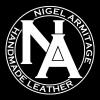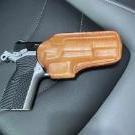-
Posts
192 -
Joined
-
Last visited
About Dangerous Beans
- Birthday 10/09/1965
Contact Methods
-
Website URL
http://www.armitageleather.com
Profile Information
-
Gender
Male
-
Location
Burton upon Trent
-
Interests
Photography, Leather, flicking peanuts at old ladies and poking badgers with spoons.
LW Info
-
Leatherwork Specialty
The unusual.
-
Interested in learning about
You!
-
How did you find leatherworker.net?
Recommendation
Recent Profile Visitors
10,112 profile views
Dangerous Beans's Achievements

Member (2/4)
-
Greetings Nigel!
In one of your videos, you had mentioned that you primarily construct your pieces in an “English” style. What exactly does this mean? Could you give examples of various styles/aesthetics?
Preston
-
As it happens, it is.
- 3 replies
-
- sailrite
- sewingmachine
-
(and 2 more)
Tagged with:
-
I have a Sailrite Ultra Feed LS1 for sale at £1200 in the UK.This machine is as new, it is the premium version with the heavy flywheel, binding attachment, flight case and all the other gubbins advertised.In addition, there are over 60 needles ranging from medium to heavy and also leather, two feet, magnetic and swing arm guide, thread stand, light, light flywheel for faster sewing, manual and toolset.It comes with 12000 meters of thread in various colours and a bunch of bobbins. This is a beast and punches through almost anything you can fit under the foot. Sailrite has a whole range of videos on this machine and each machine flys out of the shop. It is fitted to work in the UK and can be tried here in the workshop. I bought it for canvas work and dog harnesses which I'm no longer making. It can also be adapted to work by hand if power is an issue making this an ideal mobile workhorse. It is heavy so can be collected in person or you can arrange for a courier. IMG_5390.MOV IMG_5382.MOV
- 3 replies
-
- sailrite
- sewingmachine
-
(and 2 more)
Tagged with:
-
Well!!!...??? That is a surprise. Rannoch, I'm fairly sure there is no mention of this on my website and I have had no email from you, or anyone, asking about the book. However... as Schiffer seems to have let the cat out of the bag, (I was keeping this quiet) yes. I am writing a book. It is not yet the book I want to write, neither is it the book I have been asked to write. I was asked to write what was, in essence, a craft-based project book but there are many like that already out there, so we came to a compromise. There are of course projects and the techniques focus on the more modern tools rather than the traditional so pre-pricking of holes is the theme with very little awl work. I think trying to get over all the details of the traditional saddle stitch would take a book in itself. The projects are in more detail than perhaps they expected, but hopefully, I have found the balance between what they wanted to hear against what I wanted to write. I am by no stretch of the imagination a writer, I talk too much and go off-topic too often, it has been an education. It is near completion, not near enough, but I will put it out there and take what critique is offered. Be kind. Nigel Budding author and horrendous procrastinator.
-
Good morning folks, I have been asked to share my thoughts on stitching and pricking irons and give a bit of input on types and styles out there Much of what I will say is from experience and some is opinion, I will try to highlight when I add my opinion but it is fair to say, my way is not the only way. Get as much information as you can from as many sources as you can. Do not be frightened about asking folks offering advice to qualify that advice and then check it. There is a lot of misinformation out there. The Pricking iron. The traditional version of this tool if you will. This is the tool I trained with, Joseph Dixon Irons and an awl and Haft from Hoopers in Walsall (long gone) and a wooden Mallet, how times change. This is a tool designed to prick the surface of the leather marking a row of holes at set distances or SPI (Stitches Per Inch) for the worker to follow. For many years these along with Pricking Wheels were the only tools used to mark the stitching on leather. The idea was to only make a shallow hole (hence the work pricking) in the leather which acted as a locator for the awl, it was the awl that made the hole. These irons tend to have flat ends to the teeth and the tooth then broadens out up towards the body, if driven into the leather to deeply, the hole becomes enlarged and distorted. If just used to prick, a fine slit is left. This is now where the awl comes into play. Now, we have to know why this technique was used to fully appreciate the saddle stitch. Just touching on the cobblers stitch for a moment, the cobblers stitch involved a similar way of marking the holes but traditionally, the wheel was the main way of doing so. A large awl was then employed to make a large hole, a hole big enough to allow both needles to pass through at the same time crossing in the hole. This left a larger hole for the thread to sit in, I will come back to that shortly. A Saddler, Bridle or Harness Maker looked to make a hole barely big enough to get one needle through. The idea was to ensure that the thread did not ‘ride’ in the hole. If the hole was too big, the thread would ‘ride’ when the item was in use and if it did, one of two things would happen, the thread if weak, like linen, would fur and snap causing the seam to fail. If the thread was strong like polyester, it would saw at the leather cutting it and the seam would fail. It was, therefore, important to lock each stitch into place to try and prevent this riding from occurring. I am sure you can appreciate the dangers of a seam failing on a saddle or bridle when a horse is at full gallop and every seam is being stressed to the max. So, the secret in this technique was not the iron, it was the awl. The awl blade had a broad body and was tapered to a point, the point was sharp but the body was not. This ensured that the area of leather actually cut could be kept to a minimum. The awl was pushed into the hole only as far as it needed to be to get the correct size hole. Just the tip and you have a pinpoint hole, all the way to the haft and you had a much larger hole. Because the body of the awl blade was blunt, or ‘soft’ the hole was stretched by the awl body, not cut, allowing the stitch to be placed, whereupon, almost immediately, the hole began to close up. This is why only one hole at a time is made and the awl is employed on every stitch as you go. It is also important to match the correct thread and needles to the iron you are using. This is how some saddlers managed stitching as fine as 18 spi on some pieces. 14 is not uncommon, 12 is a good benchmark. So… keeping the hole as small as possible made for a stronger stitch locked into place and made it ideal for ‘working leather’. Looking back to the Cobblers Stitch with its larger hole, the stitch did not need to be locked into place as failure was less likely because less ride takes place in a pair of shoes. Therefor ‘Traditional Saddle Stitch’ is not just a case of using pricking irons and an awl, it is so much more. You need to know how to match the iron to the item, the thread to the SPI and the needles to the thread. Then you need to be able to command the awl whilst wielding two needles, keeping the horizontal and transverse lines accurate, ensure the right angle of the blade is maintained and the depth to push the awl in is the same for each stitch. All this without actually seeing the back of what you are stitching. This technique takes months to lean and longer to master. Without doubt, the difficulty here lies in commanding the awl, not the iron. Makes of the pricking ideal for this technique are Dixon, Blanchard, Amy Roke, Doldokki, Wuta and Abbey England. Pricking Irons cannot be used as Stitching Irons unless they have very fine teeth or the leather is very thin. The Stitching Iron. This looks very similar to the pricking iron but the teeth are much slimmer and today, stronger. They are designed to fully penetrate the leather sometimes up to 6mm. The idea here is to remove the need for an awl and once the holes are made, the worker can go straight to the stitch. Now, however slim the holes appear, they are still bigger than they need to be, in the wrong place, the ‘ride’ can still occur. DO NOT USE the modern stitching irons on any form of Saddle, Harness, Bridle or Tack. If you are inexperienced at making or repairing tack, you run the risk of putting someone in real danger. This equipment is designed to keep a grown adult on the back of a 1-tonne animal that is capable of travelling at 40mph. Don’t mess if you don’t know what you are doing. However… the vast majority of people today are saddle stitching accessories and small goods. In this situation, the Stitching Iron comes into its own and a seam on a Wallet, Bag, Belt, Case or Box will never be tested as that on a saddle. I have been a professional leatherworker for 30 years and teaching these skills for the past 7. I remember when these new irons appeared, my opinion was that they were tat and a gimmick. I was wrong. A great many people struggle with getting the saddle stitch right, especially using an awl. I have seen many try and just give up. However, with the irons available today, a fantastic stitch can be achieved even by a complete novice in a day. Again, the secret was not in the iron, it was the awl, remove the awl and remove the frustration. Certainly, now we have a technique totally acceptable for small leather goods. There are two types of stitching iron, the flat tooth and the diamond tooth. Some companies are calling the flat tooth version the ‘French Style’ and the Diamond the ‘Japanese Style’. Do not be tempted to use the word ‘dent’ unless speaking French properly, it is just a French word for tooth and commonly referred to when talking about round tooth irons. The French have never made round tooth irons to my knowledge. The Flat Tooth version irons leave a slit in the leather the width of the tooth and very narrow, for small leather goods, these give a very pleasing stitch and I use then for teaching here in the workshop with great success, I believe they have made good leather work more attainable for more people. A few good makes of flat tooth Stitching iron are KS Blade Punch, Crimson Hides, Kevin Lee, Amy Roke and Sinabroks. The Diamond tooth version of the Stitching irons also have their place, these leave an even bigger hole so are definitely to be avoided if working Tack. The larger hole suits a larger thread, are much easier to stitch with and suit a thick or difficult leather. Either way, they are still designed to fully penetrate the leather fully so fall under the title Stitching Iron. These types of irons are available from Crimson Hides, Kevin Lee, Doldokki and KS Blade Punch. Stitching irons can be used as pricking irons. Stitching Chisels. Whilst I have many of what are termed Stitching Chisels, I cannot be sure where the term was coined. They are in essence, a more basic version of Stitching Irons. We know a chisel is a tool for woodwork so I think it may have been a crossover in translation. Still, they work the same way, they are designed to fully punch through the leather making a hole without the need of an awl so you are ready to stitch straight away. The teeth tend to be long, straight and very thick and leave a large diamond hole. The biggest issue with these tools is that the edges of the teeth tend to be quite sharp, so the hole you make is the hole to are left with, it will not close up well so not suited to more adept leather workers. I have found them ideal for absolute beginners as the large hole they give makes it very easy to get the needles through and therefore stitch. People often get the balance wrong when stitching and have to resort to pliers, these definitely will avoid that. Some common makes of Stitching Chisels are Tandy, Seiwa, Craft-Sha and Craft-Tool. Leaving off the chisels for the time being, I would put the irons into two brackets, Traditional and Modern. The Traditional is the stitch attained using a pricking iron and awl and the modern is that using the Stitching Iron and no awl. There will always be a place for an awl so practice is encouraged, even with the modern style. Thank you to Northmounts for placing a link to my iron review in his post, here it is again: Armitage Leather Iron Review This is designed to complement the iron reviews on my YouTube Channel, Armitage Leather. So far there are about 20 and more will be added in time. I shan’t add the reviews here, you have access to the info sheet and the videos. But opinions are valuable, add yours. Unless of course you include stitch grooving or drilling holes. Then you will be sat in a corner. I will leave you to discuss, dissect and question. Always question. If you struggle with your stitching, I cover both styles, left and right-handed on my Vimeo Channel and run courses here in the workshop. All the details are on my website. I hope it helps. Warm regards to you all Nigel
- 12 replies
-
- stitching irons
- reviews
-
(and 2 more)
Tagged with:
-
Hello Japi, Normally, a quiet private message seems to resolve misunderstandings and that is how I like to deal with many issues. I do not like to air laundry in public. However, you appear to be levelling quite a severe accusation now out in the open so I think a more public approach may be prudent. I take it you are not happy with the motor, that is unfortunate, you have made contact with Just Wood to allow them to rectify any issues you may be suffering? I do not think you have emailed me asking for my input, I am suspecting not. You make mention of the power source being cheap and generic, yes, we thought it was good value too and Draper has a good name and is very affordable. You would have been well aware of this at point of purchase. As for it being single phase, I can't think of many leatherworkers that would want a burnisher running on three phase, this is the realm of constant industrial use. Those in that field are well aware of what they need and, I doubt many houses and small workshops have the ability to use three-phase machines. Onto the number of shafts, two is the most we can fit onto it so I cannot find issue there. As for the power, yes, 370W, perfect we thought, that is 1/2 a horsepower and will stop if trapped or the operator gets caught up in it with the 2amp causing it to overload and trip out preventing any serious harm. All this with enough power to get the job done. I am still not seeing evidence of this con you mention. You mention that it is "needless to say", yet you do, "it was all a con" are you referring to the deal I did? unlikely as you have no knowledge of any deal I have undertaken with Just Wood. You make no mention of the burnisher so I will surmise that you along with a great many others are happy with that, which leaves the motor. Just Wood clearly describe the motor and have an image showing the number of spindles, it leaves little room for confusion. If you bought it, you will have seen all of this so where has the confusion come from and how do you feel that you have been conned? everything you mention as a negative is clearly stated and transparent, I am at a loss Japi, are you able to help me understand your issue so I can help? In the meantime, I would be grateful if you could qualify your comment, retract it if said in error or evidence it if you stand by it. The Englishman Also called Nigel
-
I am still interested if you still have this. Not heard anything from you yet though. Nige
-
PM Sent in relation to this. Nigel
-

leather techniques Secrets from the Workshop
Dangerous Beans replied to Dangerous Beans's topic in How Do I Do That?
I don't have any background noises or music in my videos, it's just a boring old guy telling you about stuff.- 34 replies
-
- saddle stitch
- creasing
- (and 12 more)
-

leather techniques Secrets from the Workshop
Dangerous Beans replied to Dangerous Beans's topic in How Do I Do That?
Not an issue Mike, I see your point, I shall keep the videos clean of gimmicks, I have no intention to change the style, perhaps learn to use the camera and mic a little better. You make mention of liking the free-wheeled videos of Bob Ross, well if you think my videos are structured, I must be doing something right... it's all smoke and mirrors. See you in two years. Nige- 34 replies
-
- saddle stitch
- creasing
- (and 12 more)
-

leather techniques Secrets from the Workshop
Dangerous Beans replied to Dangerous Beans's topic in How Do I Do That?
Thats fine Tom, it is not a prerequisite, it is purely optional. Nige- 34 replies
-
- saddle stitch
- creasing
- (and 12 more)
-

leather techniques Secrets from the Workshop
Dangerous Beans replied to Dangerous Beans's topic in How Do I Do That?
A bunch more videos have been added since I last posted on here, there is now over 40 skill based videos on the list. The most recent covering turned and piped seams. Hope it helps. Nige- 34 replies
-
- saddle stitch
- creasing
- (and 12 more)
-

Do you consider yourself an artist?
Dangerous Beans replied to saddleman15's topic in Member Gallery
Right... I am jumping on the Mike is/is not an artist bandwagon. I have some little credibility in the leather world... some... he is an artist, a wonderful one, I am bigger than he is so that rule stands. I am now going to take umbrage on being referred to as a 'performer' I am a maker, a little tongue in cheek but this comes up in conversation quite frequently with students. I would define (within the realms of leatherwork) an artist as someone who creates something of artistic value and as so eloquently mentioned, evokes emotion by the viewer. In the medium of leather, people like Michael Dale, Peter Main, Britt Nantz, Al Stohlman and many more too numerous to mention are: artists. As for I, the performer, I do not create anything of artistic value, my work is functional, strong, yet aesthetically pleasing. It looks nice, but you would not hang any of my items on a wall or put them on display, by that rational, I am not an artist, an artisan perhaps. There is a quote, "art is art if someone calls it art" by that measure, anything can be called art, and often has, a cow in vat of formaldehyde was seen as art, that, I do not get, to me, art is the application of talent and skill to create something wondrous. Mike, that ticks that box and you have no foundation to argue the point. To now take ownership of this tirade and answer the original question, I am not an artist, I am not a performer, I am a maker, I make stuff, I am proud to be a maker. if someone wants to call my items art, that is their right to do so and I will defend their right to do so, but I think they are wrong. Art is a subjective subject, quality is not, just because something is bespoke, well made using traditional skills, does the job and is aesthetically pleasing does not alone make it art. If you then adorn that item using your talent and skill you add artistic value. Just my subjective opinion. Still not a performer :-) Nige








